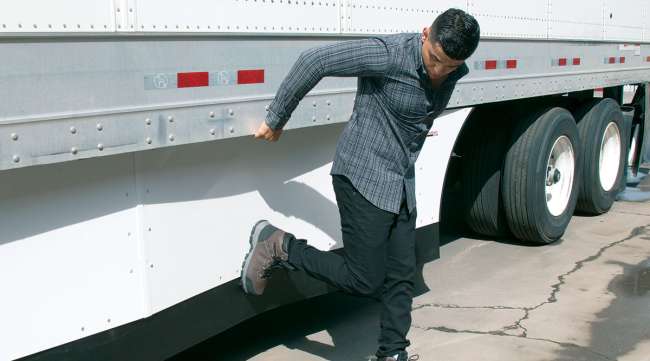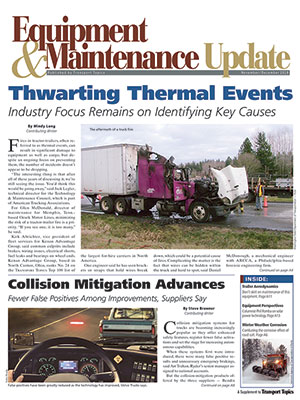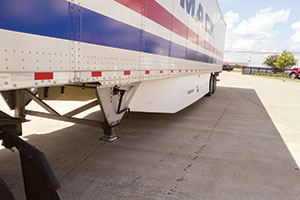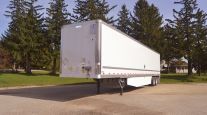Don't Skirt Proper Maintenance on Trailer Aero Devices, Experts Say

Trailer side skirts and various types of air deflectors, which are intended to boost a tractor-trailer’s aerodynamic efficiency, will save motor carriers more fuel with frequent inspections and proper repairs. That’s because anything that changes their shape or even dents their surface will increase drag, industry experts said.
“We put a lot of emphasis on the inspection each time we see the trailers,” said Tim Tipps, vice president of maintenance at Big G Express of Shelbyville, Tenn. “It’s very important to keep the skirt mounting straight and eliminate any waves in the skirt mounting,” he said, noting the biggest concern is the diagonal bracing coming loose or being driven from its original mounting position from various impacts.

- Collision Mitigation Advances
- Thwarting Thermal Events
- Here Comes the Sun
- The Analytical Dilemma
- Preventive Maintenance Helps Stop Rust Due to Road Salt
- Investigating Thermal Event Causes Is Crucial, Experts Say
- Tire Monitoring and Inflation Systems Can Lead to Fuel Savings, Longer Tire Life
- Seeking Alternative Solutions to Salt
- Don't Skirt Proper Maintenance on Trailer Aero Devices, Experts Say
Richard Senatro, president of Strehl, said side skirts redirect wind around the trailer, reducing trailer drag by preventing high-momentum air from being trapped in the trailer’s underbody. His company makes the TrailerBlade side skirt.
He summed up the task of maintaining these devices: “Strive to maintain the skirt’s original shape and profile — the point of the device is to save fuel,” Senatro said. “All skirt manufacturers certify their devices using precise configurations and methods,” he said, noting that if the skirt is bent, crooked or damaged in any way, “all this goes out the window."
A basic step in the maintenance shop is the routine inspection, said James Svaasand, vice president of collision center development and operations at Penske Truck Leasing. “A proper PM, along with driver pre-trip inspections, provide the best opportunity to ensure peak performance and safety,” he said.
“Each of the components needs to be inspected regularly for wear and damage to keep them working correctly,” Svaasand said. “The sheathing needs to be inspected for tears, bends, or detachment from the post or strut,” he said, noting the post or strut usually is attached to the crossmember and base rail. “Inspect the post for wear at the fastening points to the crossmember and sheathing.”

John Baxter
Most manufacturers struggle to continuously improve their devices to help deflect objects and prevent damage, with some designs featuring a shape or material that particularly resists road damage.
Senatro said Strehl’s side skirt uses flexible rubber for the lower skirt, “which almost eliminates bottom-impact damage.” For side impacts, it uses a steel panel around a low-density plastic core and a spring-loaded strut. “The panel is flexible enough to resist damage from moderate impacts, and harder impacts engage the springs.”
Repair techniques vary, depending on the construction and type of device. Senatro offered this tip: “Placing your back against the side of the trailer and pressing the sole of your foot firmly against the skirt will quickly tell you if anything is loose.”
Avoiding Damaged Side Skirts Starts With Drivers
Truck drivers should learn how to avoid damage to trailer side skirts and other aerodynamic devices, industry experts said. That includes objects on the road that might fly up and cause damage to a side skirt, said Steve Smith, executive vice president of sales at EkoStinger.
Richard Senatro, president of trailer side skirt manufacturer Strehl, said his company sees the highest concentration of driver-caused damage at the curbside rear. “The damage usually occurs when the driver is backing up and making a hard turn,” he said.
Backing into grade-level loading docks where the paving curves rapidly downward is a particularly hazardous situation for low-hanging side skirts, the experts said.
Tim Tipps, vice president of maintenance at Big G Express, said his fleet has found the installation of trailer side skirts has made drivers more aware of their surroundings because they didn’t want to damage one.
“We get a few calls from drivers that are amazed the skirt can take the stresses they put on them, especially in sunken docks where the skirt contacts the ground,” Tipps said.
Meanwhile, Penske Logistics designs equipment to reduce potential damage by outfitting the trailers with flexible side skirts, said Vice President of Fleet Operations Doug Macolley.
“We train our drivers to follow the GOAL process, as in ‘get out and look’ before backing up,” Macolley said. “The drivers make use of GOAL, and safety cones, to protect the asset, the general public and themselves.”
Svaasand said Penske first recommends that all repairs be made to the skirt or fairing to OEM repair specifications. “Best practices require that at least one full fairing or skirt assembly kit is in stock for maintenance repair,” he said.
Big G Express’ Tipps said his company keeps extra parts in stock for use when making repairs. “We have had success piecing together skirts by overlaying a filler piece behind the splice and riveting or bolting the two pieces to the filler,” Tipps said, noting it’s important to use good hardware.
Todd McGuire, vice president of sales at Transtex, another manufacturer of trailer side skirts, said the flexibility of its product will make damage to the fairing itself unlikely. However, he suggests an annual inspection of the metal mounting bolts although they are self-locking and normally won’t loosen up. “It can be bent over and snaps back due to its patented resiliency,” McGuire added.
Steve Smith, executive vice president of sales at EkoStinger, which makes a trailer air deflector, said the company’s device slides with the tandems to ensure it remains in the best possible position to guide air around the trailer tandems.
Its V-shaped aerodynamic fairing is made of polyethylene and designed to last the life of a trailer, Smith said.
If damage occurs, a fleet can take it to a dealer, where spare parts should be stocked for a free repair. Otherwise, the company will ship new parts to the shop free of charge, Smith said.
Meanwhile, different types of trailer aerodynamic devices need different inspection techniques.
FlowBelow Aero Inc. makes the Trailer AeroSlider, a device that prevents air from getting trapped between the trailer tandem’s wheels, and wheel covers. President Josh Butler advised checking the wheel covers for dents, as well as the brackets and the aerodynamic fins themselves for damage. He also said to check the mounting bolts to make sure they are not bent and still tight.
Of the Trailer AeroSlide device, Butler said that if damaged, “repairing it may not be safe.”
“Most large fleets take the complexity out of the process and just replace it,” he said.
Companies that make deflectors that mount in front of and move with the tandems said they can have a positive effect on trailer stability, especially in crosswinds.
AirFlow Deflector President Robert Martineau said the company’s product, which he described as “shaped like a boat,” is mounted in front of the trailer tandems and slides back and forth with them. It is designed to deflect objects rather than sustain damage. “It will last the life of the trailer,” he said.
If it cracks, it can be fixed, Martineau said. “Any body repair mechanic can repair spidering or stress cracks with fiberglass resin.”
Most reputable brands are SmartWay-certified but may vary in terms of vulnerability and actual performance, the industry experts said.



